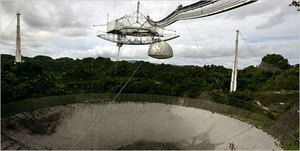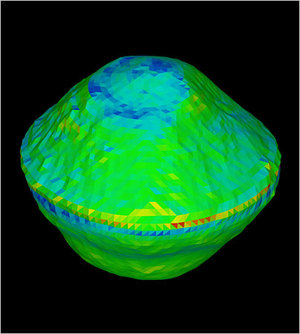
|
| ©Brennan Linsley/Associated Press |
| The Arecibo radio telescope is a thousand feet wide and 167 feet deep |
The next time an unexpected comet shows up in the inner solar system, Amy J. Lovell may not get time at the Arecibo radio telescope in Puerto Rico to observe it before it swings back out.
With a quarter of its annual budget slashed, to $8 million from $10.5 million, Arecibo will be listening to the universe less often in the coming years. For researchers like Dr. Lovell, a professor of astronomy at Agnes Scott College in Georgia, that may mean her work - detecting radio waves emitted by ions from busted-up water molecules - will take years longer to complete.
"I'm prepared to live with that," she said.
More alarming would be the closing of Arecibo in four years, a possibility that has been raised by the National Science Foundation, which pays for the operation of the telescope. "Then I'm completely up the creek without a paddle," Dr. Lovell said.
Carved in the hilly terrain, a thousand feet wide and 167 feet deep, Arecibo has been listening to radio waves arriving from the cosmos since 1963, and today it remains the world's largest and most sensitive radio telescope. It is also one of the most recognizable, appearing as a backdrop in the movies "Contact" and "GoldenEye."
In an era of tight and tightening budgets, a review panel for the foundation's astronomy division two years ago looked for places where money could be freed up for new facilities. It recommended a 25 percent cut in Arecibo's foundation financing by 2011 and then another 50 percent cut, to $4 million, in 2011.
The panel said Arecibo should look to other institutions and agencies to make up for the 2011 cut; if it could not find the money, the panel said, the foundation should consider closing it.
A quarter of its staff was laid off last year. The telescope is now on hiatus for repainting, but when it resumes operation, the number of observing hours will be cut, and nearly half of its receivers will be furloughed. Its emphasis will shift to large, continuing surveys, and smaller projects like Dr. Lovell's may be much more squeezed than in the past.
An outcry followed the review panel's decision, particularly from planetary scientists who thought that the group had overlooked Arecibo's role in cataloging potential dangers from asteroids. Its radar can precisely plot the orbit of an asteroid to determine if it could be on course for a collision with Earth.

|
| ©Steven J. Ostro/J.P.L. and Daniel J. Scheeres/University of Michigan |
| An image of the near-Earth asteroid 1999 KW4 produced by the telescope's radar systems. |
Two weeks ago, scientists and officials testified before a Congressional committee about the asteroid issue and touched on Arecibo's fate. "The planetary science community is in danger of losing one of its instrumental crown jewels," Donald K. Yeomans, a scientist at NASA's Jet Propulsion Laboratory, told the House subcommittee on space and aeronautics.
NASA is a candidate to pick up some of the financing, particularly the $1 million to $2 million annual cost of the planetary radar. The agency has contributed to the radar operations in the past, as much as $500,000, but NASA officials say their focus should be on instruments in space, not on the ground.
"We haven't asked N.S.F. to operate any of our spacecraft," said James L. Green, director of NASA's planetary science division.
Robert L. Brown, director of the National Astronomy and Ionosphere Center at Cornell University, which runs Arecibo, remains hopeful that Arecibo will stay open.
"The people at NASA and the people at the N.S.F. are reasonable people whose intentions are good," he said. "Arecibo is caught in the middle."
Cornell has also talked to the Puerto Rican government and the University of Puerto Rico. The atmospheric sciences division of the N.S.F. - Arecibo's radar is used to study the dynamics of the upper atmosphere - may end up contributing to the budget.
Something else may also weigh in Arecibo's favor: it may be much cheaper to keep it open. To dismantle the telescope and return the area to a natural state could cost hundreds of millions of dollars.



Reader Comments
to our Newsletter